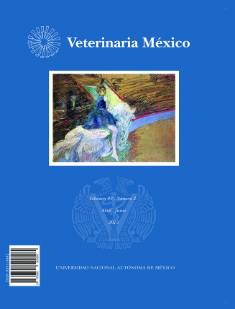Characterization of the growth curve in two species of silverside Chirostoma estor, C.promelas and their hybrids
Main Article Content
Abstract
The objective of the present study was to estimate growth curve parameters of length and weight in whitefish Chirostoma estor (EE), blacknose silverside Chirostoma promelas (PP) and their reciprocal hybrids (EP and PE) up to 300 days of age from a complete diallel cross under culture conditions in Morelia, Michoacan, Mexico. The length was measured monthly from hatching, while the weight was measured monthly from 120 days of age. The total number of each observation (samples) was analyzed for length 1006 (26), 771 (22), 513 (22) and 421 (21) for groups EP, PE, PP and EE, respectively. Total number of observations (samples) was analyzed for weight 630 (16), 521 (14), 263 (13) and 256 (13) for groups EP, PE, PP and EE, respectively. The growth curves for weight and length were estimated using nonlinear regression models. The group EE reached an estimated weight of 7.89 g at 300 days of age, 65% higher than the PP (4.78 g) and 57 % higher than the average of their hybrids (P < 0.01); EE had a length of 9.31 cm (14%) larger than PP (7.97 cm) and 13% larger than the average of their hybrids (P < 0.01). The four groups showed a positive allometric growth with values of 3.20 to 3.3 (P < 0.05). The results of this study are the first comparative estimates of growth characteristics up to 300 days of age for these species and their hybrids in captivity.
Keywords:
Allometric Coefficient Chirostoma Estor C. Promelas Growth Curve
Article Details
License

Veterinaria México OA by Facultad de Medicina Veterinaria y Zootecnia - Universidad Nacional Autónoma de México is licensed under a Creative Commons Attribution 4.0 International Licence.
Based on a work at http://www.revistas.unam.mx
- All articles in Veterinaria México OA re published under the Creative Commons Attribution 4.0 Unported (CC-BY 4.0). With this license, authors retain copyright but allow any user to share, copy, distribute, transmit, adapt and make commercial use of the work, without needing to provide additional permission as long as appropriate attribution is made to the original author or source.
- By using this license, all Veterinaria México OAarticles meet or exceed all funder and institutional requirements for being considered Open Access.
- Authors cannot use copyrighted material within their article unless that material has also been made available under a similarly liberal license.



